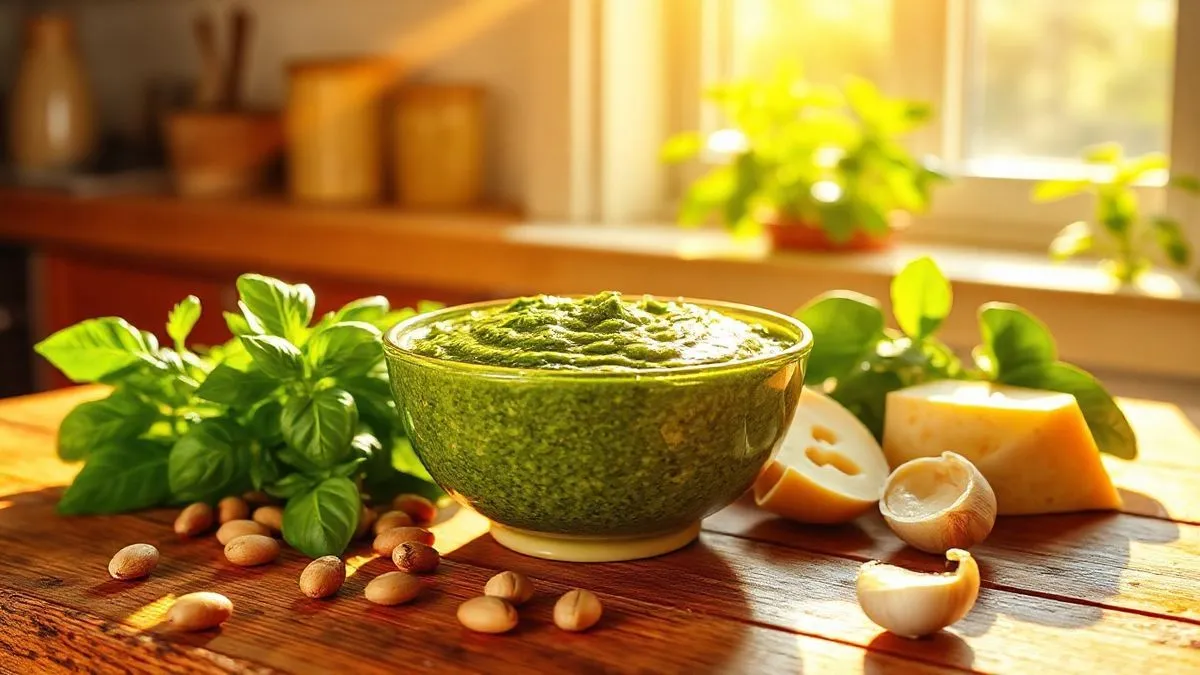Pesto is one of those magical sauces that can level up just about any dish. Whether you’re tossing it in pasta, slathering it on sandwiches, or using it as a dip, pesto is delicious and super easy to whip up! In this guide, we’ll cover everything you need to know about pesto, from its origins to variations and a complete recipe you can try at home.
What is Pesto?
Pesto originated from Italy, specifically the region of Liguria. The word “pesto” comes from pestare, which means “to pound” or “to crush” in Italian. Traditionally, it’s made by crushing fresh basil leaves, garlic, salt, pine nuts, and Parmesan cheese together with olive oil. But there are countless ways to make it!
Why Use Halal Ingredients?
When making pesto, it’s important to choose halal ingredients, especially if you’re preparing it for friends or family who follow dietary restrictions. This means avoiding cheese made with animal rennet and making sure that nuts and oils are sourced appropriately. Don’t worry, there are plenty of options to ensure your pesto remains both delicious and halal.

Key Ingredients for Traditional Pesto
1. Fresh Basil
The star of the show! Fresh basil is what gives pesto its vibrant green color and aromatic flavor.
2. Olive Oil
A good quality extra virgin olive oil adds richness and helps emulsify the mixture.
3. Garlic
Garlic gives pesto its punch. You can adjust how much you use depending on how strong you want that flavor to be.
4. Pine Nuts
These little guys add a lovely nutty flavor and creamy texture. If you’d like to swap them out, walnuts or sunflower seeds work in a pinch.
5. Cheese
For traditional pesto, Parmesan cheese is a must. Just make sure it’s halal! Alternatively, you can use nutritional yeast for a vegan twist.
6. Salt
A little salt goes a long way! It enhances the flavors of all the other ingredients.
Different Types of Pesto
While traditional pesto is beloved, there are plenty of creative versions worth exploring. Here’s a few fun twists:
1. Sun-Dried Tomato Pesto
Swap out some basil for sun-dried tomatoes. This adds a rich, tangy flavor!
2. Spinach and Kale Pesto
Mixing spinach and kale in with the basil makes for a nutrient-packed sauce—it’s a great way to sneak in more greens!
3. Avocado Pesto
For a creamy twist, blend in ripe avocado. It’s rich, smooth, and perfect for spreading on sandwiches.
4. Arugula Pesto
Arugula gives pesto a peppery kick. It’s perfect for anyone who loves a bit of spice in their sauce.
How to Make Classic Pesto
Ready to whip up some delicious pesto? Here’s a straightforward recipe that you can nail in no time!
Ingredients:
- 2 cups fresh basil leaves
- 1/2 cup extra virgin olive oil
- 1/4 cup pine nuts (or walnuts)
- 2-3 cloves of garlic (adjust to taste)
- 1/2 cup grated halal Parmesan cheese (or nutritional yeast for a vegan option)
- 1/2 teaspoon salt (or to taste)
Instructions:
-
Prep Your Ingredients: Wash the basil and peel the garlic cloves.
-
Blend the Basil and Nuts: In a food processor, combine the basil leaves and nuts. Pulse it a few times until everything is roughly chopped.
-
Add the Garlic: Toss in the garlic and pulse again to mix.
-
Stream in Olive Oil: With the food processor running, slowly drizzle in the olive oil. This step helps create that nice creamy texture.
-
Add Cheese and Salt: Now, mix in your cheese and salt. Blend until everything is well-combined and smooth. If it’s too thick, just add a bit more olive oil.
-
Taste and Adjust: This is the fun part! Take a little taste and see if you’d like to add more garlic, salt, or cheese.
-
Store or Serve: Use the pesto right away or store it in a jar in the fridge. If you’re storing it, drizzle a thin layer of olive oil on top to keep it fresh.
Serving Suggestions
So, now you’ve got homemade pesto—what do you do with it? Here are some tasty ideas:
- Pasta Sauce: Toss it with your favorite pasta, maybe a little extra cheese, and some cherry tomatoes or veggies.
- Pesto Spread: Use it on sandwiches. It adds a ton of flavor!
- Pizza Base: Spread pesto on the pizza dough before adding toppings for an awesome twist on pizza night.
- Dip: Serve it as a dip with fresh veggies or breadsticks.
Pesto Storage Tips
Pesto is super easy to store! Here are some tips to keep it fresh:
- Refrigerate: Keep your pesto in an airtight container in the fridge, and it’ll last for about a week.
- Freeze: If you made a big batch, freeze small portions in ice cube trays. Once they’re frozen, pop them out and store in a zip-lock bag. You’ll have individual portions ready for pasta or sandwiches later!
Common Questions About Pesto
What can I substitute for pine nuts?
If you’re allergic to nuts or just can’t find pine nuts, walnuts, sunflower seeds, or even cashews work well.
Can I make pesto in advance?
Absolutely! Pesto can be made ahead of time and stored in the fridge for up to a week or frozen for a few months.
Is pesto safe for a halal diet?
Yes, just make sure to select halal cheese and confirm your nuts and oils are sourced correctly.
Can I use dried herbs instead of fresh?
Fresh herbs are best for a vibrant flavor, but if you must, you can use dried basil. Just remember, dried herbs are more potent. You might need less!
Pesto is not only easy to make but also incredibly versatile. Whether you stick to the classic or try out some unique twists, this flavorful sauce can elevate your meals in so many ways. So grab those fresh basil leaves, and get ready to add some Italian flair to your dishes. Enjoy!



